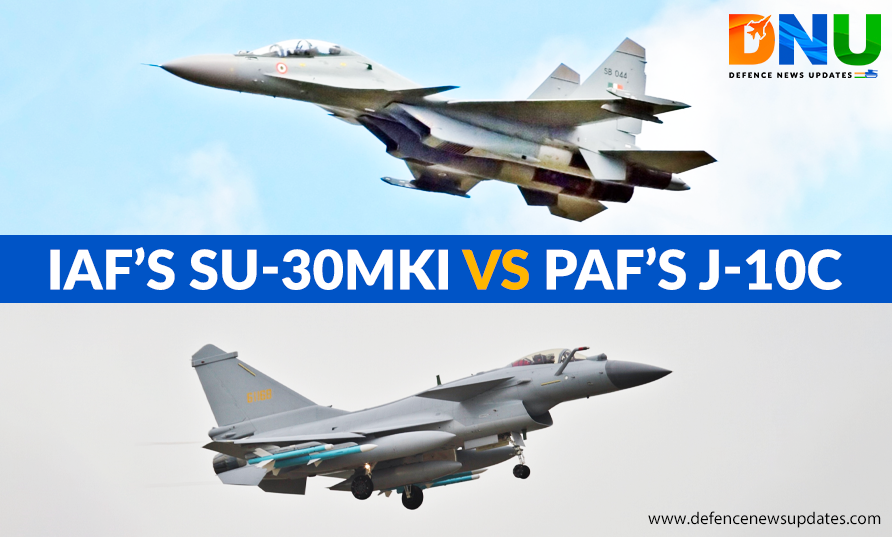The announcement that Pakistan will be the first customer for the Chinese J-10C ‘4++ generation’ single-engine fighter has sparked a flurry of speculation about the Pakistani Air Force’s future and how the balance of power in South Asia will be influenced.
Pakistan’s Interior Minister, Sheikh Rasheed, confirmed the purchase in late December, saying that the Air Force would field a full J-10C squadron in time for the country’s March 23rd Parade. The fighter will undoubtedly be Pakistan’s most capable, complementing the lighter and less expensive JF-17 Block III, which first flew in 2019 and has comparable avionics and weaponry but worse flight performance.
The extent to which the J-10C will be able to threaten the primacy of the region’s most competent fighters, the Indian Air Force’s fleet of Su-30MKI ‘4+ generation’ heavyweight fighters, is unknown. Su-30s have been in service with the Indian Air Force since the late 1990s, with the improved MKI variant becoming the backbone of the country’s combat fleet in 2002.
There are already over 270 in service, with more on the way in 2022. Due to its widespread employment and elite status, the Su-30MKI is the most likely fighter for the Indian Air Force to face off against the J-10C in air to air combat.
The Su-30MKI has a number of significant advantages over the J-10C as a heavyweight fighter. The aircraft has a far better endurance, which means it can carry significantly more ordinance over much longer distances, which is useful for offensive operations or long-range patrols. It has a second seat for a weapons systems officer, which is very useful while performing severe movements or targeting both ground and airborne targets at the same time.
Indeed, Chinese fighter pilots claimed that the J-16 heavyweight fighter had an advantage over the J-10C in mock encounters because of its double seats. Because of its higher speed and altitude, the Su-30 can fire missiles with far more energy than comparable fighters.
This includes not only the J-10C, but also the Rafale lightweight aircraft, which are even slower and lower flying than the J-10 and which India recently bought from France. Despite being a lighter design, the J-10 has a number of major advantages of its own. The aircraft, which will enter service 16 years after the Su-30MKI, benefits from China’s far greater technological foundation and scale of research and development, and boasts superiority in avionics, especially in sensors and electronics.
The J-10C uses an AESA radar, which, while smaller than the Su-30MKI’s Bars PESA radar, is far more difficult to jam, more efficient, and provides additional electronic warfare options.
The PL-15 long-range air-to-air missile is used by the fighter, which outperforms the Russian R-77 and the French MICA used by the Su-30. This is true not only in terms of range (250-300km vs. 110km for R-77 and 80km for MICA), but also in terms of sensors, as it is the first operational air-to-air missile outside of Japan verified to have an AESA radar for guidance.
The PL-15 is now not just less susceptible to jamming, but also more dependable and capable of forming locks against stealth targets.
Both fighters use Mach 3 capable missiles for standoff air to ground and anti-shipping operations, the YJ-93 for the J-10C based on the Russian Kh-31 and the BrahMos for the Su-30MKI. The BrahMos is a more heavier, but more capable missile that takes use of the Su-30’s long endurance. Su-30MKI units, unlike the J-10C, which can rearm with the YJ-93 at base, require modifications to operate the BrahMos and specific units designated to carry the missiles, restricting the Su-30’s versatility.
For air-to-air combat at shorter ranges, the J-10C’s PL-10 missile with great off boresight aiming capability is projected to provide a significant edge over Indian fighters.
With two thrust vectoring engines, the J-10C is possibly the only non-Russian fighter in the world that can match the Su-30MKI in manoeuvrability, while the lighter Chinese aircraft has a greater thrust/weight ratio due to its airframe’s extensive use of light composite materials. The J-10 has the highest altitude ceiling of any operational single-engine fighter in the world, however it is still somewhat lower than the Su-30MKI.
Aside from its cheaper operational expenses and maintenance requirements, the J-10C’s principal advantage over the Su-30MKI is its superior electronics and data linkages, which allow units to better and more reliably network with other assets such as drones and air defence systems to combat an adversary.
This is regarded to be the main reason why J-10Cs were able to outperform Russian-built Su-35 heavyweight fighters in mock air combat in 2020. In Pakistani hands, the J-10C will present the Indian Air Force with a challenge it hasn’t experienced since the Cold War, with Indian superiority long assured by the Su-30MKI and, prior to the mid-1980s, MiG-29s armed with R-27 missiles.
Despite this, the Su-30MKI is an outdated fighter compared to more recent Russian fighter designs, and if modernised with next-generation technologies, it has the ability to close performance disparities, if not handily beat the J-10C.
R-37M missiles with 400km engagement ranges, Iribis-E PESA radars or N036 AESA radar variants, AL-41 engines, as well as modern avionics and electronic warfare systems are among them. While the Su-30MKI is a higher-end fighter in the same weight range as the Chinese J-16, and was widely regarded as the world’s most capable fighter when it first entered service in 2002, many of its technologies are now outdated, allowing lighter, more sophisticated aircraft like the J-10C to challenge its formerly undisputed superiority in the region.
Despite the fact that Pakistan’s J-10C purchases are projected to be a fraction of the size of India’s present Su-30MKI fleet, with only a single squadron confirmed so far, the Indian Air Force will maintain a numerical edge despite its top fighters being more heavier and more expensive.
